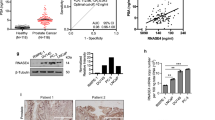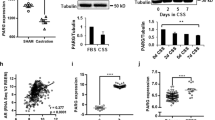Abstract
The enzymes thymidylate synthase (TS), dihydropyrimidine dehydrogenase (DPD), thymidine phosphorylase (TP), and orotate phosphoribosyl transferase (OPRT) are involved in the metabolism of the anticancer drug 5-fluorouracil. No reports have examined the expression of these enzymes in prostate cancer (CaP). A total of 25 previously untreated, hormone-sensitive CaP tissue samples and 11 benign prostatic hyperplasia (BPH) specimens were examined. Tissue of CaP and BPH tissue samples were obtained from formalin-fixed, paraffin-embedded sections by laser-captured microdissection, and then RNA was extracted. mRNA expression of TS, DPD, TP, and OPRT was analyzed by quantitative reverse transcriptase-polymerase chain reaction. TS and OPRT expression levels were significantly higher in CaP samples than in BPH. DPD expression level in poorly differentiated CaP was significantly lower than that in CaP with more favorable—well or moderately differentiated—histopathology.
This is a preview of subscription content, access via your institution
Access options
Subscribe to this journal
Receive 4 print issues and online access
$259.00 per year
only $64.75 per issue
Buy this article
- Purchase on Springer Link
- Instant access to full article PDF
Prices may be subject to local taxes which are calculated during checkout



Similar content being viewed by others
References
Parker SL, Tong T, Bolden S, Wingo PA . Cancer statistics, 1997. CA Cancer J Clin 1997; 47: 5–27.
Oh WK, Kantoff PW . Management of hormone refractory prostate cancer: current standards and future prospects. J Urol 1998; 160: 1220–1229.
Kubota Y et al. Do the worst histological elements in needle biopsy specimens of prostate cancer predict prognosis? Lancet 1996; 348: 822–823.
Longley DB, Harkin DP, Johnston PG . 5-Fluorouracil: mechanisms of action and clinical strategies. Nat Rev Cancer 2003; 3: 330–338.
Droz JP et al. Phase II study of oxaliplatin versus oxaliplatin combined with infusional 5-fluorouracil in hormone refractory metastatic prostate cancer patients. Ann Oncol 2003; 14: 1291–1298.
Shinohara N et al. 5-Fluorouracil and low-dose recombinant interferon-alpha-2a in patients with hormone-refractory adenocarcinoma of the prostate. Prostate 1998; 35: 56–62.
Danenberg PV . Thymidylate synthetase—a target enzyme in cancer chemotherapy. Biochim Biophys Acta 1977; 473: 73–92.
Santi DV, McHenry CS, Sommer H . Mechanism of interaction of thymidylate synthetase with 5-fluorodeoxyuridylate. Biochemistry 1974; 13: 471–481.
Johnston PG, Drake JC, Trepel J, Allegra CJ . Immunological quantitation of thymidylate synthase using the monoclonal antibody TS 106 in 5-fluorouracil-sensitive and -resistant human cancer cell lines. Cancer Res 1992; 52: 4306–4312.
Johnston PG et al. The role of thymidylate synthase expression in prognosis and outcome of adjuvant chemotherapy in patients with rectal cancer. J Clin Oncol 1994; 12: 2640–2647.
Pestalozzi BC et al. Prognostic importance of thymidylate synthase expression in early breast cancer. J Clin Oncol 1997; 15: 1923–1931.
Shintani Y et al. New prognostic indicator for non-small-cell lung cancer, quantitation of thymidylate synthase by real-time reverse transcription polymerase chain reaction. Int J Cancer 2003; 104: 790–795.
Mizutani Y et al. Significance of thymidylate synthase activity in renal cell carcinoma. Clin Cancer Res 2003; 9: 1453–1460.
Foekens JA et al. Thymidine kinase and thymidylate synthase in advanced breast cancer: response to tamoxifen and chemotherapy. Cancer Res 2001; 61: 1421–1425.
Kuniyasu T, Nakamura T, Tabuchi Y, Kuroda Y . Immunohistochemical evaluation of thymidylate synthase in gastric carcinoma using a new polyclonal antibody: the clinical role of thymidylate synthase as a prognostic indicator and its therapeutic usefulness. Cancer 1998; 83: 1300–1306.
Johnston PG et al. Thymidylate synthase gene and protein expression correlate and are associated with response to 5-fluorouracil in human colorectal and gastric tumors. Cancer Res 1995; 55: 1407–1412.
Fraile RJ et al. Pharmacokinetics of 5-fluorouracil administered orally, by rapid intravenous and by slow infusion. Cancer Res 1980; 40: 2223–2228.
Diasio RB, Harris BE . Clinical pharmacology of 5-fluorouracil. Clin Pharmacokinet 1989; 16: 215–237.
Jiang W, Lu Z, He Y, Diasio RB . Dihydropyrimidine dehydrogenase activity in hepatocellular carcinoma: implication in 5-fluorouracil-based chemotherapy. Clin Cancer Res 1997; 3: 395–399.
Etienne MC et al. Response to fluorouracil therapy in cancer patients: the role of tumoral dihydropyrimidine dehydrogenase activity. J Clin Oncol 1995; 13: 1663–1670.
Mizutani Y et al. The significance of dihydropyrimidine dehydrogenase (DPD) activity in bladder cancer. Eur J Cancer 2001; 37: 569–575.
Ichikawa W et al. Both gene expression for orotate phosphoribosyltransferase and its ratio to dihydropyrimidine dehydrogenase influence outcome following fluoropyrimidine-based chemotherapy for metastatic colorectal cancer. Br J Cancer 2003; 89: 1486–1492.
Mizutani Y et al. Prognostic significance of orotate phosphoribosyltransferase activity in bladder carcinoma. Cancer 2004; 100: 723–731.
Mizutani Y et al. Significance of orotate phosphoribosyltransferase activity in renal cell carcinoma. J Urol 2004; 171: 605–610.
Ishikawa F et al. Identification of angiogenic activity and the cloning and expression of platelet-derived endothelial cell growth factor. Nature 1989; 338: 557–562.
Lord RV et al. Telomerase reverse transcriptase expression is increased early in the Barrett’s metaplasia, dysplasia, adenocarcinoma sequence. J Gastrointest Surg 2000; 4: 135–142.
Heid CA, Stevens J, Livak KJ, Williams PM . Real time quantitative PCR. Genome Res 1996; 6: 986–994.
Gibson UE, Heid CA, Williams PM . A novel method for real time quantitative RT-PCR. Genome Res 1996; 6: 995–1001.
General Rule for Clinical and Pathological Studies on Prostate Cancer, 3rd edn. Japanese Urological Association, The Japanese Society of Pathology: Kanehara, Tokyo, 2001.
Ishikawa T et al. Positive correlation between the efficacy of capecitabine and doxifluridine and the ratio of thymidine phosphorylase to dihydropyrimidine dehydrogenase activities in tumors in human cancer xenografts. Cancer Res 1998; 58: 685–690.
Terashima M et al. Role of thymidine phosphorylase and dihydropyrimidine dehydrogenase in tumour progression and sensitivity to doxifluridine in gastric cancer patients. Eur J Cancer 2002; 38: 2375–2381.
Ishikawa Y et al. Thymidylate synthetase and dihydropyrimidine dehydrogenase levels in gastric cancer. Anticancer Res 1999; 19: 5635–5640.
Johnson MR et al. Life-threatening toxicity in a dihydropyrimidine dehydrogenase-deficient patient after treatment with topical 5-fluorouracil. Clin Cancer Res 1999; 5: 2006–2011.
Takabayashi A et al. Dihydropyrimidine dehydrogenase activity and mRNA expression in advanced gastric cancer analyzed in relation to effectiveness of preoperative 5-fluorouracil-based chemotherapy. Int J Oncol 2000; 17: 889–895.
Horiguchi J et al. Prognostic significance of dihydropyrimidine dehydrogenase expression in breast cancer. Br J Cancer 2002; 86: 222–225.
Nakagawa T et al. Predictive value of dihydropyrimidine dehydrogenase expression in tumor tissue, regarding the efficacy of postoperatively administered UFT (Tegafur+Uracil) in patients with p-stage I nonsmall-cell lung cancer. J Surg Oncol 2002, 8187–8192.
Author information
Authors and Affiliations
Corresponding author
Rights and permissions
About this article
Cite this article
Miyoshi, Y., Uemura, H., Ishiguro, H. et al. Expression of thymidylate synthase, dihydropyrimidine dehydrogenase, thymidine phosphorylase, and orotate phosphoribosyl transferase in prostate cancer. Prostate Cancer Prostatic Dis 8, 260–265 (2005). https://doi.org/10.1038/sj.pcan.4500817
Received:
Revised:
Accepted:
Published:
Issue Date:
DOI: https://doi.org/10.1038/sj.pcan.4500817
Keywords
This article is cited by
-
High expression of stathmin 1 is a strong prognostic marker in oral squamous cell carcinoma patients treated by docetaxel-containing regimens
Clinical and Experimental Medicine (2017)
-
Role of tumor angiogenesis in gallbladder carcinoma: with special reference to thymidine phosphorylase
International Journal of Clinical Oncology (2008)
-
Successful treatment of advanced gallbladder cancer with an anticancer drug S-1: assessment based on intratumoral gene
International Journal of Clinical Oncology (2008)



